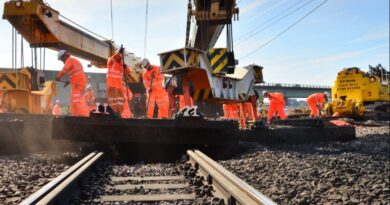What is clear air turbulence and how did it affect the Singapore Airlines flight from London?
A passenger has died aboard Singapore Airlines flight SQ321 after the flight from London Heathrow to Singapore encountered severe turbulence.
Along with the death, around 50 of the 211 passengers and 18 crew on board were injured, it has been reported.
Singapore Airlines “offers its deepest condolences to the family of the deceased” and says it is working with the authorities in Thailand to provide the necessary medical assistance.
What more do we know about this tragedy?
Singapore Airlines flight SQ321, nonstop from London Heathrow to Singapore, took off at 10.37pm on Monday night for a routine flight to Southeast Asia . It appears the Boeing 777-300 encountered clear air turbulence over the Bay of Bengal, south of the southern tip of Myanmar, just before 9am British time. A turn towards Bangkok and a rapid descent from the cruising altitude began at 9.07am UK time.
The aircraft landed in the Thai capital at 9.45am.
At the time the aircraft encountered the clear air turbulence, about 90 minutes remained of the expected flight time to Singapore. It is likely that crew would have been moving around the cabin dealing with breakfast, together with a number of passengers.
The Boeing 777-300 had been delivered to Singapore Airlines in February 2008.
It is likely to remain on the ground until engineers are satisfied that it suffered no structural damage.
What is the safety record of Singapore Airlines?
Excellent. The only Singapore Airlines accident to result in fatalities involved a Boeing 747 ‘Jumbo jet’ taking off from Taipei in the year 2000. The pilots mistakenly attempted to take off from a closed runway, and collided with construction equipment. Of the 179 passengers and crew on board, 83 died and 96 survived.
What is clear air turbulence?
The US National Weather Service says: “Turbulence is caused by abrupt, irregular movements of air that create sharp, quick updrafts/downdrafts. These updrafts and downdrafts occur in combinations and move aircraft unexpectedly.”
The US Federal Aviation Administration (FAA) defines clear air turbulence as “sudden severe turbulence occurring in cloudless regions that causes violent buffeting of aircraft… CAT is especially troublesome because it is often encountered unexpectedly and frequently without visual clues to warn pilots of the hazard.”
Is it unusual for a fatality as a result of turbulence?
Yes, very rare. But injuries on board an aircraft can be alarming. Writing for the British Airline Pilots’ Association (Balpa), former pilot and flight safety specialist Steve Landells says: “The injuries we see tend to occur when people aren’t strapped in. This may be because the turbulence is encountered without warning but we also see quite a lot of people hurt because they don’t obey the ‘fasten seat belt’ instructions.
Cabin crew are particularly vulnerable.
How often does this sort of incident happen?
One study suggests aircraft encounter severe clear air turbulence at least 790 times a year, which works out at once every 11 hours. But climate researchers say the incidence at a typical point over the North Atlantic increased by 55 per cent between 1979 and 2020.
According to Paul Williams, Professor of Atmospheric Science in the Department of Meteorology at the University of Reading, a doubling of carbon dioxide (CO2) levels in the atmosphere would increase hazardous turbulence on commercial flights, making it twice or even three times more common than it is today – with five serious cases a day on average.
What can passengers do to limit the danger?
The most basic precaution is keeping your seatbelt at least loosely fastened whenever seated.
Steve Landells of Balpa says: “Don’t be tempted to get up when the captain has told you to strap in; we are always talking to the pilots of aircraft ahead of us and, even if it is smooth when we put the signs on, we may know it is going to get bumpy soon.”
If the pilot instructs the cabin crew to strap in, the likelihood is that the turbulence is going to be severe.
What does clear air turbulence feel like?
It is either a sudden, very scary bump in the flight, possibly with a turn involved, or a more protracted series of uncomfortable vertical movements. The feeling has been likened to a theme-park ride in which you keep going round and round without a chance to get off.
Can turbulence bring down an aircraft?
Not a modern jet such as the Boeing 777. As with this tragedy, it is events within the cabin that are most dangerous.




